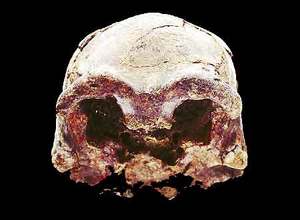
|
| ©Brill Atlanta |
| Photo from cover of Nature March 2002 |
Frank Brown, a professor of geology and geophysics and dean of the University of Utah College of Mines and Earth Sciences, and Patrick Gathogo, a U. geology doctoral student, worked with seven researchers to determine that two species of early humans coexisted rather than evolved from each other. Their study will be published today in the journal Nature.
Brown and Gathogo dated the mineral feldspar found in the layers of volcanic ash found above and below the fossils. The first fossil is a 1.44 million-year-old jawbone of Homo habilis, the earliest species of our genus, Homo. It showed that for at least a half-million years, Homo habilis lived alongside Homo erectus in east Africa, contrary to the popular view that erectus evolved from habilis.
"People have been thinking of evolution of humans as a linear progression," Gathogo said. "What this discovery shows is that they are actually overlapping so it's not necessarily true to say that Homo erectus came from habilis."
If the fossils have been correctly identified as to which species they belong, "then the most important conclusion is that there was more than one species of early man for an extended period of time in East Africa," said Brown in a written statement from the field in Kenya. He should return to Utah later this month.
The other fossil is a 1.55 million-year-old skull of Homo erectus, which is much smaller than a previously discovered fossil, indicating the species was much less like modern humans, called Homo sapiens, than believed. The skull-size variations also suggest Homo erectus males may have had multiple mates.
"As you go through time, in general there was more than one hominid. Yet today Homo is represented by only a single species: us," Brown said in his statement.
Gathogo said he, Brown and Ian McDougall of the Australian National University will continue to search for more sites in East Africa.
"We want to find and date more fossils to make the story clear," he said.



Humans are sooo ethnocentric. They are the only ones in the universe, they are the highest evolved creatures on the face of the earth, they were made by The One God. Geez.
Wonder what would happen if they began to understand that there were, oh, maybe three different types of beings walking the earth as 'home sapiens.' Adamic, preadamic and psychopathic. The Divine loves diversity.